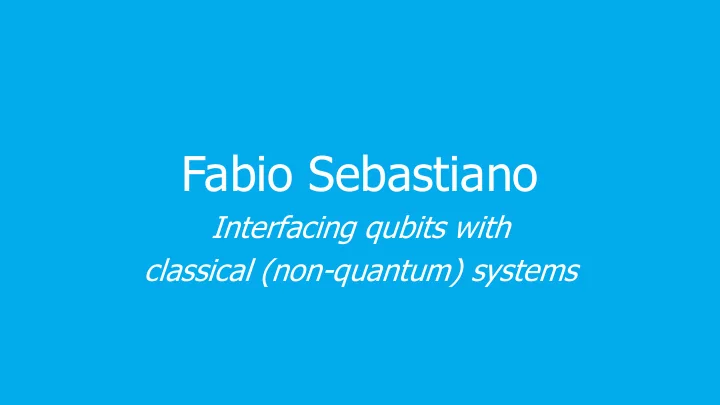

Fabio Sebastiano Interfacing qubits with classical (non-quantum) systems
A real-life quantum computer Electronic interface Quantum processor
Example – Single-qubit rotation Microwave pulse I f ~ 5 GHz – 20 GHz
Example – Read-out Charge sensor matching 50-Ω LNA network coax R QPC +Δ R V out ≈ 50 Ω ≈ 25 kΩ R L = 50 Ω f c = 200 MHz
A real-life quantum computer Electronic interface Quantum processor
A real-life quantum computer Electronic interface Quantum processor
A scalable quantum computer? State of the art A scalable approach Electronic interface T = 300 bulky equipment K T = 4 K Electronic interface tailor-made T ≪ 1 K Quantum processor Quantum processor
A scalable quantum computer! ADC MUX ADC N-qubit Digital Quantum control Processor DAC DEMUX DAC Optical interface may also be T sensor References required T = 20 mK – 100 mK T = 1 K - 4 K T = 300 K
Challenges • Performance Constant voltages Microwave pulses Read-out Stability < 1 μV Frequency > 12 GHz • • Noise < 100 pV/√Hz • Resolution > 10 bit • Kick-back < 100 μV • Timing accuracy < 100 ps •
Challenges 300 K • Performance 50 K Cooling • Power dissipation power 4 K ~ 1 W @ 4 K < 1 mW @ 20 mK 20 mK
Challenges Minimum • Performance temperature • Power dissipation Si BJT 100 K • Cryogenic technology Ge BJT 20 K – Operate @ 4 K, 20 mK, … SiGe HBT < 1 K – Superconducting devices (RSFQ, RQL, SQUID, …) GaAs MESFET 40 K – Semiconductors CMOS 30 mK or below? @ low-temperature
A scalable quantum computer ADC MUX ADC N-qubit Digital Quantum control Processor DAC Challenges DEMUX • Performance DAC • Power • Cryogenic T sensor References T = 20 mK – 100 mK T = 1 K - 4 K T = 300 K
Recommend
More recommend